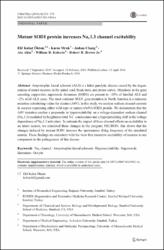Mutant SOD1 protein increases Na(v)1.3 channel excitability

Göster/
Erişim
info:eu-repo/semantics/openAccessTarih
2016Yazar
Kubat Öktem, ElifMruk, Karen
Chang, Joshua
Akın, Ata
Kobertz, William R.
Brown, Robert H., Jr.
Üst veri
Tüm öğe kaydını gösterKünye
Kubat Öktem, E., Mruk, K., Chang, J., Akın, A., Kobertz, W. R. ve Brown, Robert H., Jr. (2016). Mutant SOD1 protein increases Na(v)1.3 channel excitability. Journal of Biological Physics, 42(3), 351-370. https://dx.doi.org/10.1007/s10867-016-9411-xÖzet
Amyotrophic lateral sclerosis (ALS) is a lethal paralytic disease caused by the degeneration of motor neurons in the spinal cord, brain stem, and motor cortex. Mutations in the gene encoding copper/zinc superoxide dismutase (SOD1) are present in similar to 20% of familial ALS and similar to 2% of all ALS cases. The most common SOD1 gene mutation in North America is a missense mutation substituting valine for alanine (A4V). In this study, we analyze sodium channel currents in oocytes expressing either wild-type or mutant (A4V) SOD1 protein. We demonstrate that the A4V mutation confers a propensity to hyperexcitability on a voltage-dependent sodium channel (Na(v)1.3) mediated by heightened total Na+ conductance and a hyperpolarizing shift in the voltage dependence of Na(v)1.3 activation. To estimate the impact of these channel effects on excitability in an intact neuron, we simulated these changes in the program NEURON; this shows that the changes induced by mutant SOD1 increase the spontaneous firing frequency of the simulated neuron. These findings are consistent with the view that excessive excitability of neurons is one component in the pathogenesis of this disease.

















